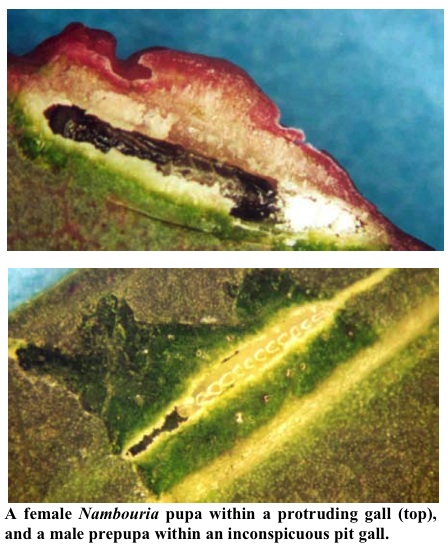PESTS AND DISEASES OF FORESTRY IN NEW ZEALAND
Female wasps more demanding than males
Scion is the leading provider of forest-related knowledge in New Zealand
Formerly known as the Forest Research Institute, Scion has been a leader in research relating to forest health for over 50 years. The Rotorua-based Crown Research Institute continues to provide science that will protect all forests from damage caused by insect pests, pathogens and weeds. The information presented below arises from these research activities.
from Forest Health News 112, October 2001.
Over the past 12 months Toni Withers, Belinda Gresham, and Jackie Van der Waals (Forest Research) have been investigating the biology of the gall wasp, Nambouria sp. (Pteromalidae) which parasitises Eucalyptus nicholii. This Australian insect is still confined to the Auckland region where it was first recorded in 1999 (FHNews 93: 1). Field identification is aided by the appearance of a distinctive, reddish, undulating, ridge-like gall that projects up to 3 mm from opposite sides of the host leaf, rather like the comb crowning the head of a rooster. However, careful examination of affected leaves soon revealed a second type of gall. Besides the obvious protruding "rooster's comb", there were also inconspicuous galls on some leaves, hardly visible except as a white line when the leaf was held up against the light.

Careful dissection revealed that male wasps occupy only the inconspicuous galls, while the females emerge from the larger protruding galls. Adult male Nambouria wasps are smaller and more slender than the females, which have bulging abdomens that may contain up to 600 eggs in large individuals. Apparently a greater requirement for nutrients by the female larvae for a larger body size and maturing eggs place greater stress on the host leaf tissues. The leaf responds to this in a complex way, possibly by varying the rate of cell division in the cells surrounding the feeding larva.
Toni Withers, Forest Research
This information is intended for general interest only. It is not intended to be a substitute for specific specialist advice on any matter and should not be relied on for that purpose. Scion will not be liable for any direct, indirect, incidental, special, consequential or exemplary damages, loss of profits, or any other intangible losses that result from using the information provided on this site.
(Scion is the trading name of the New Zealand Forest Research Institute Limited.)



